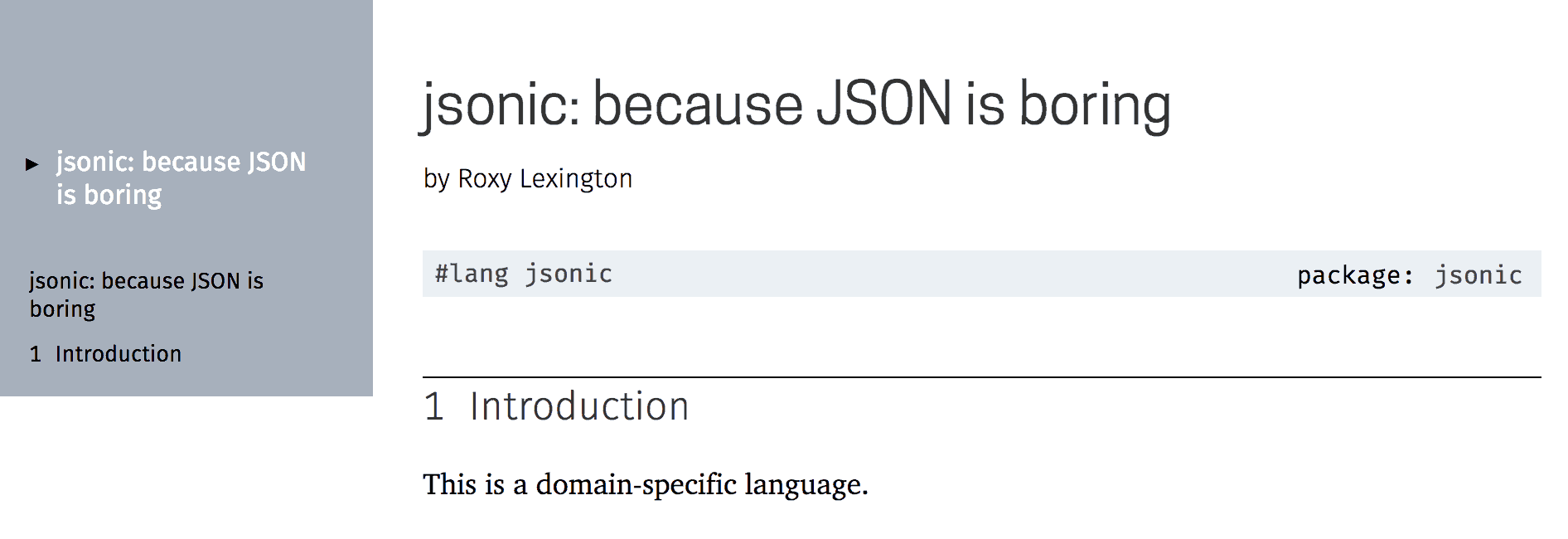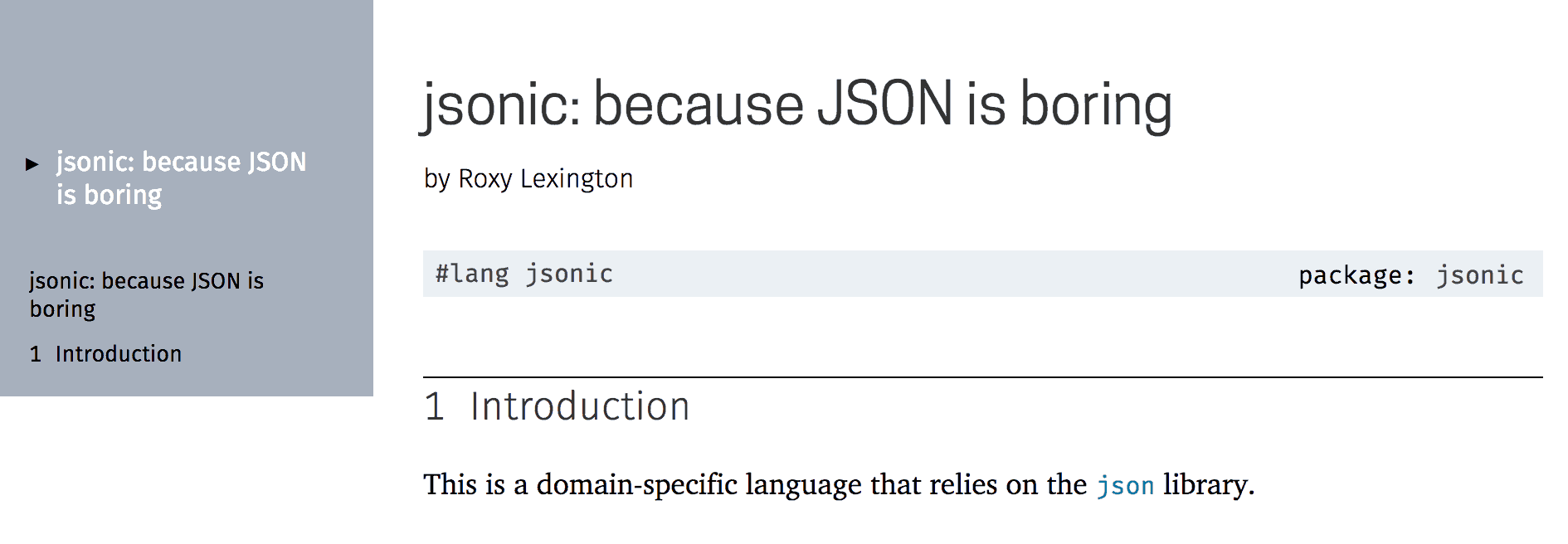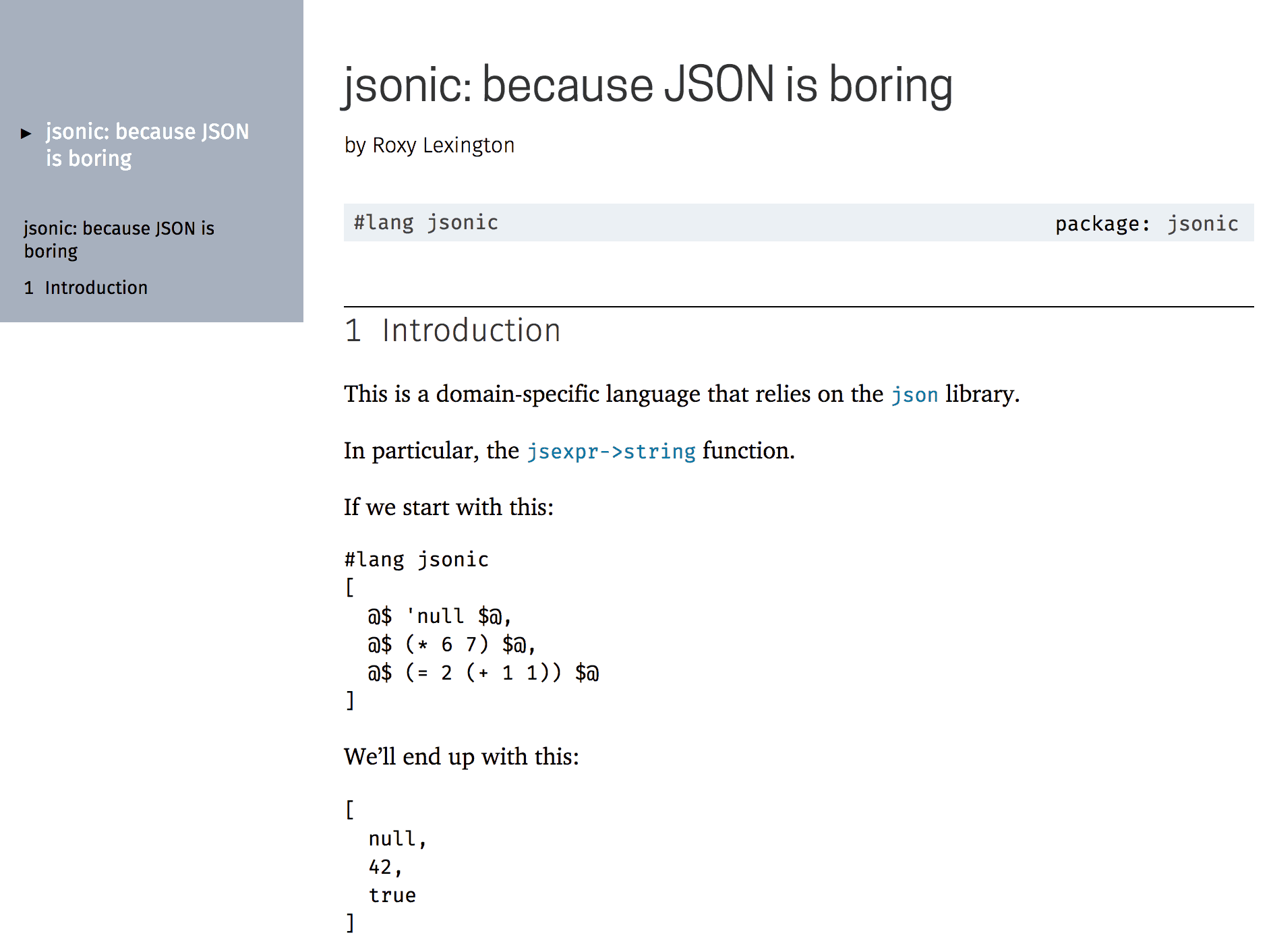Beautiful Racket / tutorials
- (list 42 #f "hello world")
1(list 42 #f "hello world")
@list[42 #f]{hello world}1@list[42 #f]{hello world}
- @(list 42 #f "hello world")
1@(list 42 #f "hello world")
jsonic/scribblings/jsonic.scrbl
#lang scribble/manual
1 | #lang scribble/manual |
jsonic/scribblings/jsonic.scrbl
#lang scribble/manual
@title{jsonic: because JSON is boring}
@defmodulelang[jsonic]
This is a domain-specific language.
@title{jsonic: because JSON is boring}
@defmodulelang[jsonic]
This is a domain-specific language.
1 2 3 4 5 6 7 | #lang scribble/manual @title{jsonic: because JSON is boring} @defmodulelang[jsonic] This is a domain-specific language. |
jsonic/scribblings/jsonic.scrbl
#lang scribble/manual
@title{jsonic: because JSON is boring}
@author{Roxy Lexington}
@defmodulelang[jsonic]
@section{Introduction}
This is a domain-specific language.
@title{jsonic: because JSON is boring}
@author{Roxy Lexington}
@defmodulelang[jsonic]
@section{Introduction}
This is a domain-specific language.
1 2 3 4 5 6 7 8 9 10 | #lang scribble/manual
@title{jsonic: because JSON is boring}
@author{Roxy Lexington}
@defmodulelang[jsonic]
@section{Introduction}
This is a domain-specific language.
|
jsonic/scribblings/jsonic.scrbl
#lang scribble/manual
@title{jsonic: because JSON is boring}
@author{Roxy Lexington}
@defmodulelang[jsonic]
@section{Introduction}
This is a domain-specific language
that relies on the @racketmodname[json] library.
@title{jsonic: because JSON is boring}
@author{Roxy Lexington}
@defmodulelang[jsonic]
@section{Introduction}
This is a domain-specific language
that relies on the @racketmodname[json] library.
1 2 3 4 5 6 7 8 9 10 11 | #lang scribble/manual
@title{jsonic: because JSON is boring}
@author{Roxy Lexington}
@defmodulelang[jsonic]
@section{Introduction}
This is a domain-specific language
that relies on the @racketmodname[json] library.
|
jsonic/scribblings/jsonic.scrbl
#lang scribble/manual
@(require (for-label json))
@title{jsonic: because JSON is boring}
@author{Roxy Lexington}
@defmodulelang[jsonic]
@section{Introduction}
This is a domain-specific language
that relies on the @racketmodname[json] library.
In particular, the @racket[jsexpr->string] function.
@(require (for-label json))
@title{jsonic: because JSON is boring}
@author{Roxy Lexington}
@defmodulelang[jsonic]
@section{Introduction}
This is a domain-specific language
that relies on the @racketmodname[json] library.
In particular, the @racket[jsexpr->string] function.
1 2 3 4 5 6 7 8 9 10 11 12 13 14 | #lang scribble/manual @(require (for-label json)) @title{jsonic: because JSON is boring} @author{Roxy Lexington} @defmodulelang[jsonic] @section{Introduction} This is a domain-specific language that relies on the @racketmodname[json] library. In particular, the @racket[jsexpr->string] function. |
jsonic/scribblings/jsonic.scrbl
#lang scribble/manual
@(require (for-label json))
@title{jsonic: because JSON is boring}
@author{Roxy Lexington}
@defmodulelang[jsonic]
@section{Introduction}
This is a domain-specific language
that relies on the @racketmodname[json] library.
In particular, the @racket[jsexpr->string] function.
If we start with this:
@verbatim{
#lang jsonic
[
@$ 'null $@,
@$ (* 6 7) $@,
@$ (= 2 (+ 1 1)) $@
]
}
We'll end up with this:
@verbatim{
[
null,
42,
true
]
}
@(require (for-label json))
@title{jsonic: because JSON is boring}
@author{Roxy Lexington}
@defmodulelang[jsonic]
@section{Introduction}
This is a domain-specific language
that relies on the @racketmodname[json] library.
In particular, the @racket[jsexpr->string] function.
If we start with this:
@verbatim{
#lang jsonic
[
@$ 'null $@,
@$ (* 6 7) $@,
@$ (= 2 (+ 1 1)) $@
]
}
We'll end up with this:
@verbatim{
[
null,
42,
true
]
}
1 2 3 4 5 6 7 8 9 10 11 12 13 14 15 16 17 18 19 20 21 22 23 24 25 26 27 28 29 30 31 32 33 34 35 | #lang scribble/manual
@(require (for-label json))
@title{jsonic: because JSON is boring}
@author{Roxy Lexington}
@defmodulelang[jsonic]
@section{Introduction}
This is a domain-specific language
that relies on the @racketmodname[json] library.
In particular, the @racket[jsexpr->string] function.
If we start with this:
@verbatim{
#lang jsonic
[
@$ 'null $@,
@$ (* 6 7) $@,
@$ (= 2 (+ 1 1)) $@
]
}
We'll end up with this:
@verbatim{
[
null,
42,
true
]
}
|
jsonic/scribblings/jsonic.scrbl
#lang scribble/manual
@(require (for-label json))
@title{jsonic: because JSON is boring}
@author{Roxy Lexington}
@defmodulelang[jsonic]
@section{Introduction}
This is a domain-specific language
that relies on the @racketmodname[json] library.
In particular, the @racket[jsexpr->string] function.
If we start with this:
@verbatim|{
#lang jsonic
[
@$ 'null $@,
@$ (* 6 7) $@,
@$ (= 2 (+ 1 1)) $@
]
}|
We'll end up with this:
@verbatim{
[
null,
42,
true
]
}
@(require (for-label json))
@title{jsonic: because JSON is boring}
@author{Roxy Lexington}
@defmodulelang[jsonic]
@section{Introduction}
This is a domain-specific language
that relies on the @racketmodname[json] library.
In particular, the @racket[jsexpr->string] function.
If we start with this:
@verbatim|{
#lang jsonic
[
@$ 'null $@,
@$ (* 6 7) $@,
@$ (= 2 (+ 1 1)) $@
]
}|
We'll end up with this:
@verbatim{
[
null,
42,
true
]
}
1 2 3 4 5 6 7 8 9 10 11 12 13 14 15 16 17 18 19 20 21 22 23 24 25 26 27 28 29 30 31 32 33 34 35 | #lang scribble/manual
@(require (for-label json))
@title{jsonic: because JSON is boring}
@author{Roxy Lexington}
@defmodulelang[jsonic]
@section{Introduction}
This is a domain-specific language
that relies on the @racketmodname[json] library.
In particular, the @racket[jsexpr->string] function.
If we start with this:
@verbatim|{
#lang jsonic
[
@$ 'null $@,
@$ (* 6 7) $@,
@$ (= 2 (+ 1 1)) $@
]
}|
We'll end up with this:
@verbatim{
[
null,
42,
true
]
}
|




